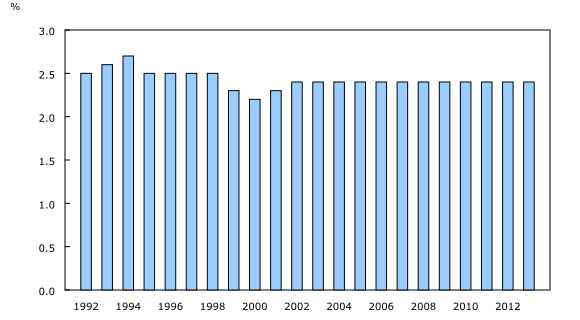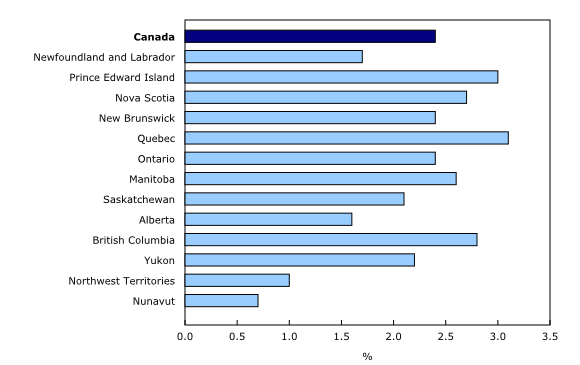The underground economy in Canada, 2013
Archived Content
Information identified as archived is provided for reference, research or recordkeeping purposes. It is not subject to the Government of Canada Web Standards and has not been altered or updated since it was archived. Please "contact us" to request a format other than those available.
Released: 2016-06-20
Underground economic activity for 2013 totalled $45.6 billion in Canada, or about 2.4% of gross domestic product (GDP). Since 2002, this proportion has been stable at 2.4%. The highest proportion was 2.7% in 1994, while the lowest was 2.2% in 2000.
In 2013, three industries accounted for more than half of the total underground economy value added: residential construction (27.8%), retail trade (12.5%), and accommodation and food services (11.7%).
Underground economic activity can also be examined from the perspective of expenditure-based GDP. In 2013, household final consumption expenditure accounted for 65.2% of underground economic activity. Business gross fixed capital formation accounted for 27.9% and net exports represented the remaining 6.9%.
Underground activities related to household final consumption expenditure were $2,156 per household in 2013. The top five categories of underground expenditure per household were food and beverage services ($461 per household), rental fees for housing ($406), tobacco ($211), alcoholic beverages ($160), and the operation of transportation vehicles ($117).
Examined from the perspective of income-based GDP, the largest share of the underground economy income went to employees (46.9%) in the form of labour compensation, followed by corporations (28.3%) in the form of surplus and unincorporated businesses (24.8%) in the form of mixed income. Wages not accounted for in payroll records and tips on undeclared transactions totalled $21.4 billion in 2013, equivalent to 2.2% of official GDP data of compensation of employees. This amount represented $1,518 for every job in the business sector in 2013.
Underground economy by province and territory
The total value of underground economic activity in 2013 was highest in the four largest economies: Ontario ($16.7 billion), Quebec ($11.1 billion), British Columbia ($6.3 billion) and Alberta ($5.3 billion).
Despite changes in the value of underground activity, the underground economy as a proportion of GDP was relatively stable in every province and territory in 2013. The underground economy as a proportion of GDP was the largest in Quebec, while it was smallest in Nunavut and the Northwest Territories.
The underground economy accounted for 3.1% of GDP in Quebec in 2013. Industries such as retail trade, which are more prone to underground production, make up a greater share of Quebec's economy compared with other provinces and territories. Conversely, industries such as mining, quarrying and oil and gas extraction, which tend to have a lower incidence of underground activity, are less important in Quebec's economy compared with other provinces and territories.
As a proportion of GDP, Nunavut (0.7%) and the Northwest Territories (1.0%) had the smallest underground economy. This study assumes that there is no underground activity in the government sector and that underreporting of revenues (or over-reporting of expenses) is less likely to occur in highly-regulated industries or in large businesses. Public administration and mining, quarrying and oil and gas extraction make up large shares of the economies of Nunavut and the Northwest Territories.
From 2007 to 2013, underground economic activity as a share of GDP was fairly stable across all provinces and territories. The largest variations occurred in Prince Edward Island (from 3.6% in 2007 to 3.0% in 2013) and Nunavut (from 1.1% to 0.7%).
Note to readers
Available today are data on the underground economy by province and territory for the reference years 2007 to 2013. Initial data are available for reference year 2013, as are revised data for reference years 2007 to 2012. Data at the national level are available for reference years 1992 to 2013.
In this release, the underground economy is defined as consisting of market-based economic activities, whether legal or illegal, that escape measurement because of their hidden, illegal or informal nature. For the purpose of this study, some illegal activities, such as those related to drugs and prostitution, have been excluded.
The study presents underground economy data based on the three methods of measuring gross domestic product (GDP): the expenditure-based approach, the income-based approach and the industry-based approach. The data presented in this release are in current dollars. However, the study provides data adjusted for inflation at the national level but not at the provincial or territorial level.
The underground economy data are fully integrated with the current framework of the Canadian System of National Accounts.
Readers should be careful in interpreting the results of this study. First, data presented give an upper bound, as recommended by the Organisation for Economic Co-operation and Development handbook on measuring the non-observed economy. To derive these bounds, assumptions were made to estimate the maximum potential underground activity beyond what is already included in GDP using standard methods. Second, by its very nature, it is difficult to obtain information on the underground economy; therefore, data necessarily rely on assumptions, indicative information and various indirect methods. Third, official GDP already includes some implicit and explicit adjustments for underground activity. For these reasons, the data calculated in this study cannot simply be added to the official GDP to arrive at a measure of GDP including the underground economy. Data are also less likely to be as accurate or reliable as other System of Macroeconomic Accounts data.
Products
The System of Macroeconomic Accounts module, accessible from the Browse by key resource module of our website, features an up-to-date portrait of national and provincial economies and their structure.
Data tables for the provinces and territories from 2007 to 2013, and for Canada from 1992 to 2013, are available upon request.
The paper, "Methodology for measuring the underground economy by province and territory," is now available as part of the Latest Developments in the Canadian Economic Accounts (13-605-X). From the Browse by key resource module of our website, choose Publications.
Contact information
For more information, or to enquire about the concepts, methods or data quality of this release, contact us (toll-free 1-800-263-1136; 514-283-8300; STATCAN.infostats-infostats.STATCAN@canada.ca) or Media Relations (613-951-4636; STATCAN.mediahotline-ligneinfomedias.STATCAN@canada.ca).
- Date modified:



